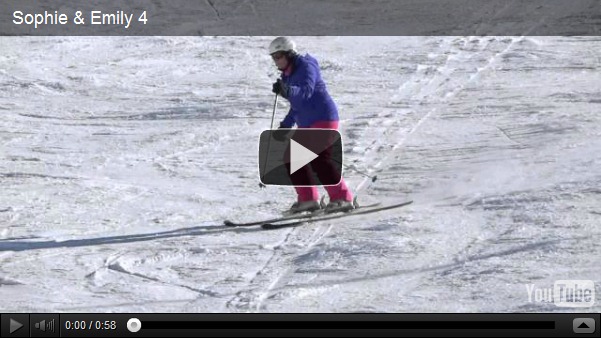The main focus today remained on consolidating confidence for Sophie. Emily was doing a good job of being patient and working on building her own technique. She has the morning skiing with a group of children her own age so she has a lot of freedom there and any time spent building her technique here is working strongly to her advantage.
Base of Support
Emily’s dynamics hadn’t been great up until now and her turns had remained rushed. Adding the feet and adductor muscles (inside of the leg) to the dynamics changed all of that. One problem with dynamics is that if the support at the feet is not correct then it can be almost impossible to generate effective dynamics. Suddenly Emily’s turns became rounded and smooth with her stance changing, combining inclination and angulation, all coming from a good “skaters” support at the level of the feet. Sophie’s stance automatically narrowed and although her “glitch” didn’t disappear completely it was much less due to the narrowed stance. Previously the “glitch” caused a big separation of the skis. Pulling inwards with the “outside” leg was giving Sophie a much better base of support. Before we used the feet and adductors along with the dynamics we did a static exercise where I stood in place of the “Magic Wall” and the feelings were generated when leaning downhill against me.
Feet Forward
To combat upper body rotation on Sophie’s right side (turning to the left ) I introduced “feet forward” technique. We did a static exercise with the skis off which both Sophie and Emily managed very well. It’s a hard exercise to do but the work with the feet rolling and the adductors made it much easier for them. The feet are initially pointed across the hill and the body supported on the lower leg (and ski poles) with the weight on the heel to act as a pivot point. The upper foot is pushed forward along the inside edge of the boot to scribe an arc in the snow. The purpose of this is to feel the sensation of pushing forward – with no twisting action involved. When this is done with the skis on it “drives” the turn, tightening the arc more the faster and harder the foot is pushed forward. It’s a very powerful way of controlling turn radius and at the same time limiting unwanted upper body rotation. Sophie managed this well and was now well within her comfort zone tackling a long blue run.

